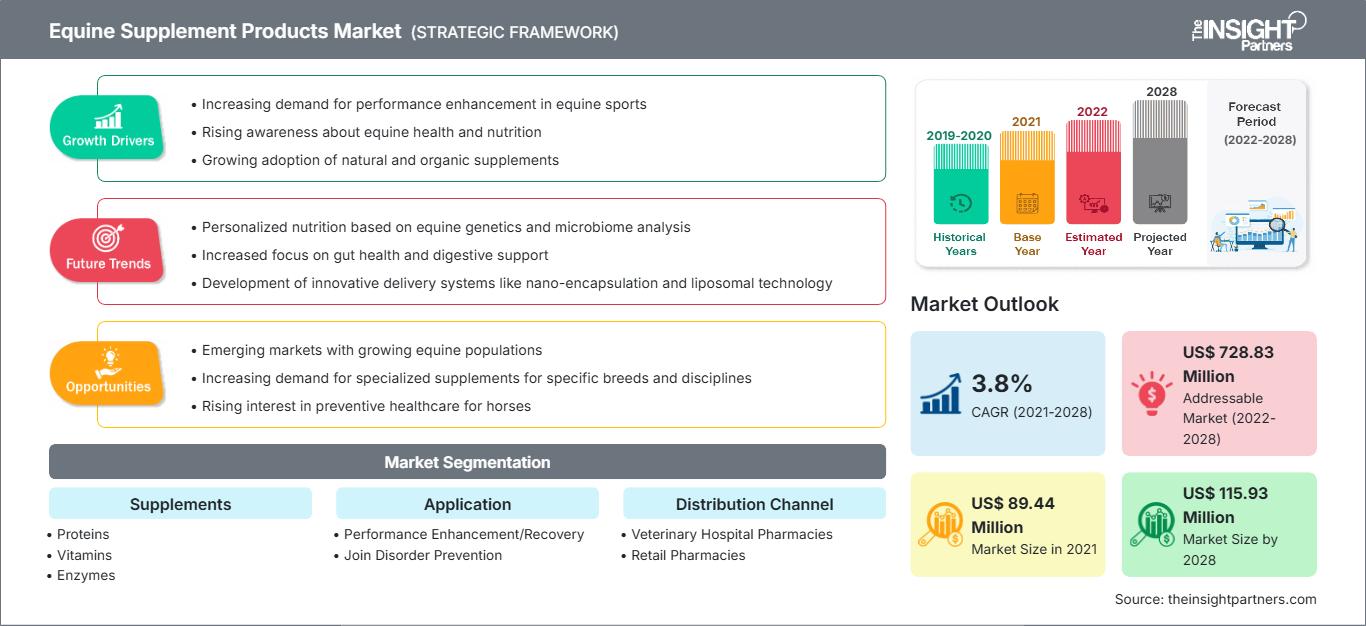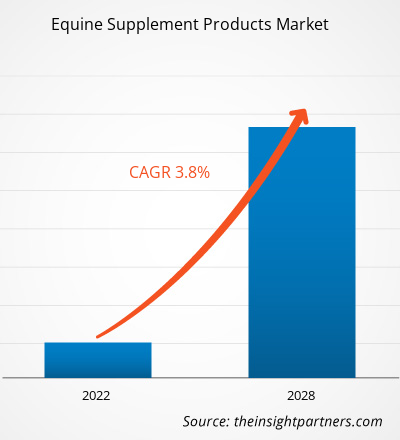Se espera que el mercado de suplementos para equinos alcance los US$ 115.932,42 mil en 2028, frente a los US$ 89.436,31 mil de 2021. Se estima que el mercado crecerá a una tasa de crecimiento anual compuesta (TCAC) del 3,8 % entre 2021 y 2028.
Los factores clave que impulsan el crecimiento del mercado son los beneficios que ofrecen los suplementos equinos y el aumento de la prevalencia de enfermedades en los equinos. Sin embargo, es probable que los efectos adversos del consumo inadecuado de suplementos equinos obstaculicen el crecimiento del mercado.
Obtendrá personalización en cualquier informe, sin cargo, incluidas partes de este informe o análisis a nivel de país, paquete de datos de Excel, así como también grandes ofertas y descuentos para empresas emergentes y universidades.
Mercado de suplementos para equinos: perspectivas estratégicas

- Obtenga las principales tendencias clave del mercado de este informe.Esta muestra GRATUITA incluirá análisis de datos, desde tendencias del mercado hasta estimaciones y pronósticos.
Perspectivas del mercado
Beneficios que ofrecen los suplementos para equinos
Los propietarios y cuidadores de caballos utilizan frecuentemente suplementos equinos para complementar la nutrición de sus animales. Estos suplementos ayudan a prevenir deficiencias de electrolitos, vitaminas y minerales, además de mejorar la salud general de los caballos, equilibrando así su dieta y optimizando su rendimiento deportivo. Gracias a sus ventajas, como aliviar problemas de salud, prevenir su aparición y modificar el comportamiento equino, los suplementos equinos han adquirido una gran importancia como alimento nutricional.
Nutrientes como la metionina, la biotina y el zinc favorecen la salud de los equinos al mejorar su digestión gracias a los probióticos. Además, el consumo de suplementos equinos mejora la calidad del tejido córneo y desarrolla un pelaje y una piel más sanos al mejorar la producción de colágeno y queratina. Además, ayudan a los caballos a calmar su sistema nervioso. Algunos suplementos específicos contribuyen a una mejor salud articular, mejorando el aporte de líquido sinovial.
Los caballos de alto rendimiento consumen energía constantemente y requieren niveles de proteínas superiores a los habituales, que no pueden obtener de la alimentación habitual. Por lo tanto, los suplementos equinos de alta calidad, como los suplementos para equinos, permiten a los caballos restaurar sus reservas de trifosfato de adenosina (ATP), las principales moléculas que estimulan las contracciones musculares.
Por lo tanto, es probable que las ventajas que ofrece un consumo equilibrado de suplementos equinos expliquen el crecimiento del mercado durante los próximos años.
Perspectivas basadas en suplementos
En cuanto a suplementos, el mercado de suplementos equinos se segmenta en electrolitos/minerales, vitaminas, proteínas/aminoácidos y enzimas. En 2021, el segmento de suplementos de electrolitos/minerales representó la mayor participación del mercado. El crecimiento de este segmento se atribuye a la demanda de suplementos herbales para equinos, el aumento en la incidencia de enfermedades equinas y el incremento de las iniciativas gubernamentales. Se estima que este mismo segmento registrará una mayor tasa de crecimiento anual compuesta (TCAC) durante el período de pronóstico.
Perspectivas basadas en aplicaciones
Según la aplicación, el mercado de suplementos equinos se segmenta en mejora del rendimiento/recuperación, prevención de trastornos articulares y otros. Este segmento tuvo la mayor participación en 2021, y se prevé que el segmento de prevención de trastornos articulares registre la mayor tasa de crecimiento anual compuesta (TCAC) durante el período de pronóstico.
Información basada en canales de distribución
El mercado de suplementos equinos, por canal de distribución, se segmenta en farmacias de hospitales veterinarios, farmacias minoristas y otros. El segmento de farmacias y clínicas de hospitales veterinarios tuvo la mayor participación de mercado en 2021, mientras que se prevé que el segmento en línea registre la mayor tasa de crecimiento anual compuesta (TCAC) del 4,6 % durante el período de pronóstico.
Las empresas clave como Boehringer Ingelheim International GmbH; EQUINE PRODUCTS UK LTD.; Kentucky Equine Research; Lallemand, Inc.; Plusvital Limited; Purina Animal Nutrition LLC.; Vetoquinol SA; Virbac; Zoetis Inc.; y Cargill, Incorporated adoptan diversas estrategias orgánicas e inorgánicas para mejorar sus ingresos y su posición en el mercado. Por ejemplo, en febrero de 2020, Equine Products UK Ltd lanzó No More Bute, un suplemento alimenticio complementario para caballos que contiene curcumina biodisponible. Tiene hasta 185 veces más biodisponibilidad que la cúrcuma y la curcumina de origen nativo. Además, en junio de 2019, Boehringer Ingelheim se asoció con Constantia Flexibles para desarrollar una solución de envasado para el suplemento nutricional equino, Nutraxin. El producto, envasado en la innovadora solución de envasado CONSTANTIA Interactive, está actualmente disponible en Alemania y los Países Bajos.
Perspectivas regionales del mercado de suplementos para equinos
Los analistas de The Insight Partners han explicado detalladamente las tendencias regionales y los factores que influyen en el mercado de suplementos equinos durante el período de pronóstico. Esta sección también analiza los segmentos y la geografía del mercado de suplementos equinos en Norteamérica, Europa, Asia Pacífico, Oriente Medio y África, y Sudamérica y Centroamérica.
Alcance del informe de mercado de suplementos para equinos
| Atributo del informe | Detalles |
|---|---|
| Tamaño del mercado en 2021 | US$ 89,44 millones |
| Tamaño del mercado en 2028 | US$ 115,93 millones |
| CAGR global (2021-2028) | 3,8% |
| Datos históricos | 2019-2020 |
| Período de pronóstico | 2022-2028 |
| Segmentos cubiertos | Por suplementos
|
| Regiones y países cubiertos | América del norte
|
| Líderes del mercado y perfiles de empresas clave |
|
Densidad de actores del mercado de suplementos equinos: comprensión de su impacto en la dinámica empresarial
El mercado de suplementos para equinos está creciendo rápidamente, impulsado por la creciente demanda del usuario final debido a factores como la evolución de las preferencias de los consumidores, los avances tecnológicos y un mayor conocimiento de los beneficios del producto. A medida que aumenta la demanda, las empresas amplían su oferta, innovan para satisfacer las necesidades de los consumidores y aprovechan las tendencias emergentes, lo que impulsa aún más el crecimiento del mercado.

- Obtenga una descripción general de los principales actores clave del mercado de productos de suplementos equinos
Mercado de suplementos para equinos: por suplementos
- Electrolitos/minerales
- Vitaminas
- Proteínas/Aminoácidos
- Enzimas
Mercado de suplementos para equinos: por aplicación
- Mejora del rendimiento/Recuperación
- Únase a la prevención de trastornos
- Otros
Mercado de suplementos para equinos: por canal de distribución
- Farmacias y Clínicas de Hospitales Veterinarios
- Farmacias minoristas y droguerías
- En línea
Mercado de suplementos para equinos por geografía
- América del norte
- A NOSOTROS
- Canadá
- México
- Europa
- Francia
- Alemania
- Italia
- Reino Unido
- Rusia
- Resto de Europa
- Asia Pacífico (APAC)
- Porcelana
- India
- Japón
- Australia
- Corea del Sur
- Taiwán
- Resto de Asia Pacífico
- Oriente Medio y África (MEA)
- Sudáfrica
- Arabia Saudita
- Emiratos Árabes Unidos
- Resto de Oriente Medio y África
- América del Sur y Central (SCAM)
- Brasil
- Argentina
- Resto de América del Sur y Central
Perfiles de empresas
- Boehringer Ingelheim International GmbH
- PRODUCTOS EQUINOS REINO UNIDO LTD.
- Investigación equina de Kentucky
- Lallemand, Inc.
- Plusvital Limitada
- Purina Nutrición Animal LLC.
- Vetoquinol SA
- Virbac
- Zoetis Inc.
- Cargill, Incorporated
- Análisis histórico (2 años), año base, pronóstico (7 años) con CAGR
- Análisis PEST y FODA
- Tamaño del mercado, valor/volumen: global, regional y nacional
- Industria y panorama competitivo
- Conjunto de datos de Excel
Informes recientes
Informes relacionados
Testimonios
Razón para comprar
- Toma de decisiones informada
- Comprensión de la dinámica del mercado
- Análisis competitivo
- Información sobre clientes
- Pronósticos del mercado
- Mitigación de riesgos
- Planificación estratégica
- Justificación de la inversión
- Identificación de mercados emergentes
- Mejora de las estrategias de marketing
- Impulso de la eficiencia operativa
- Alineación con las tendencias regulatorias




















 Obtenga una muestra gratuita para - Mercado de suplementos para equinos
Obtenga una muestra gratuita para - Mercado de suplementos para equinos